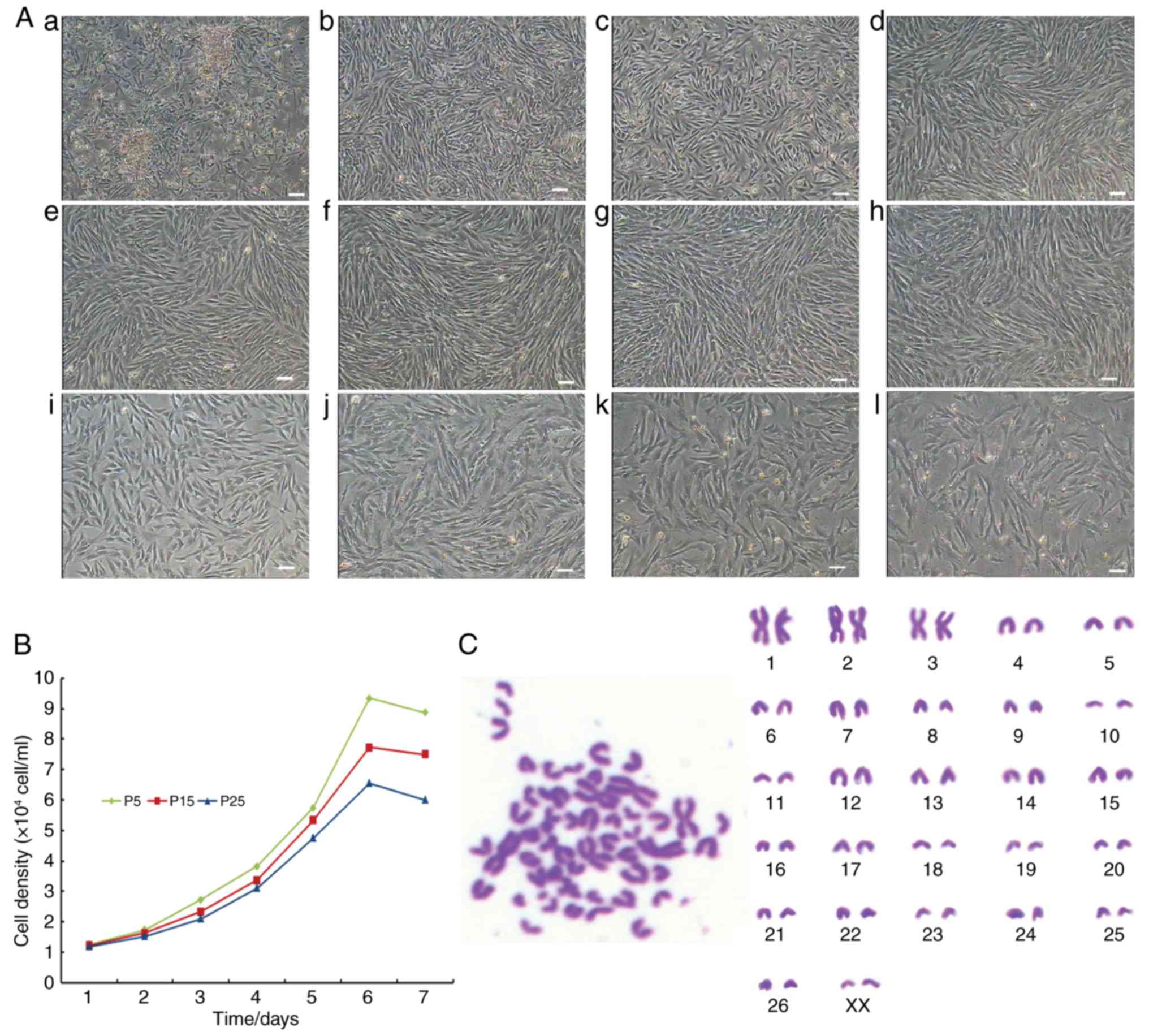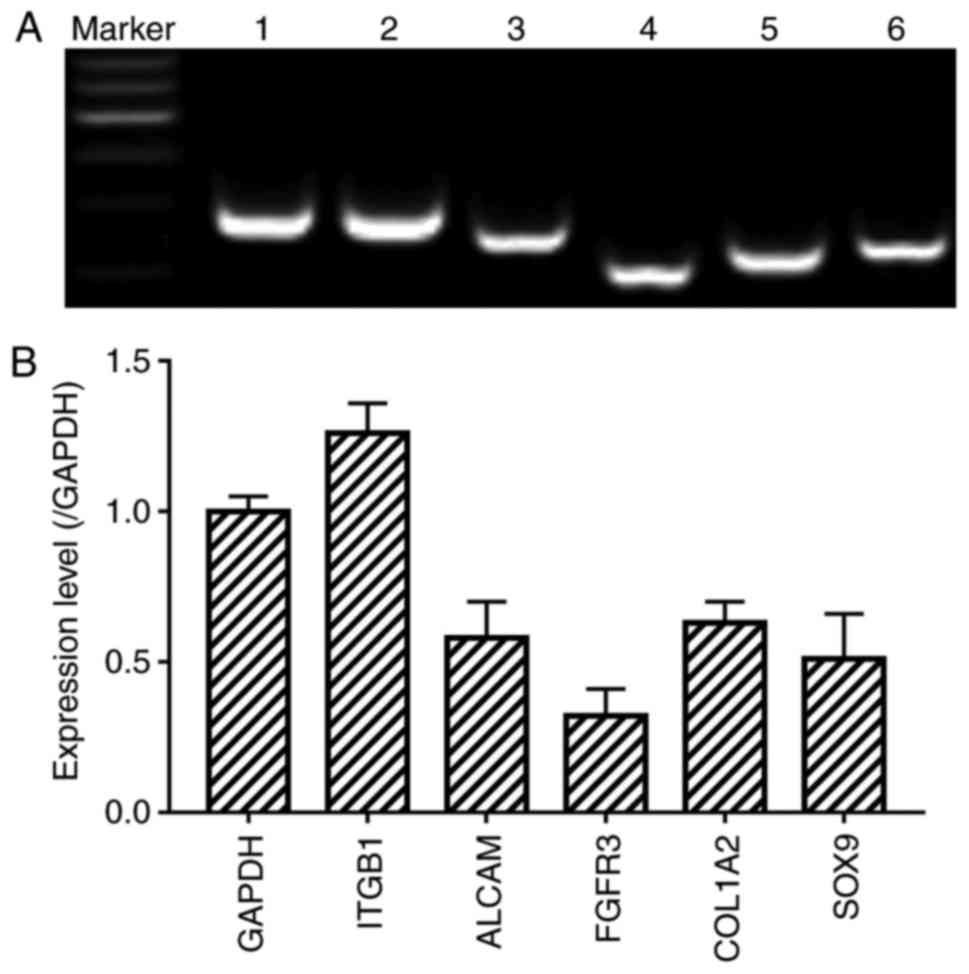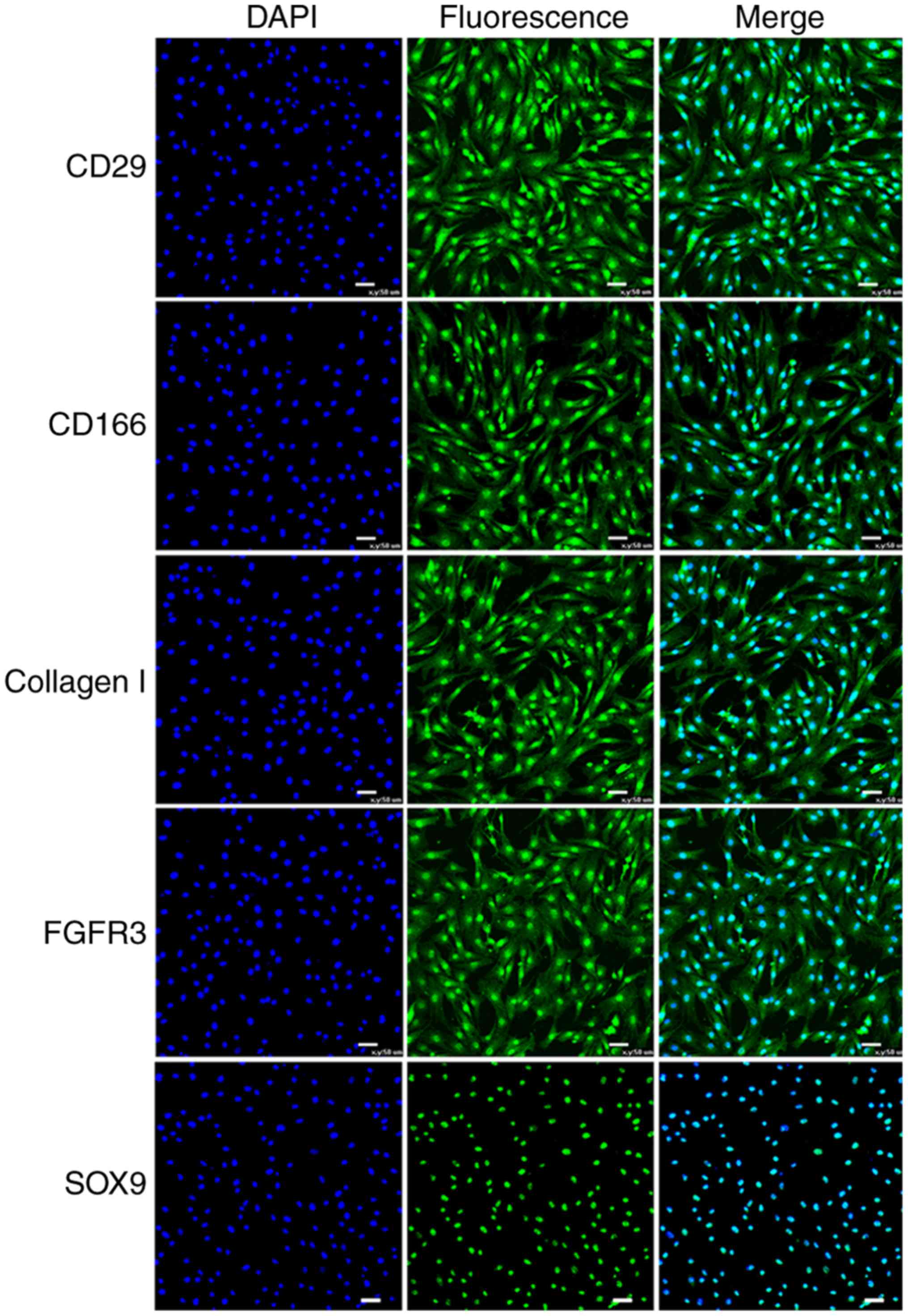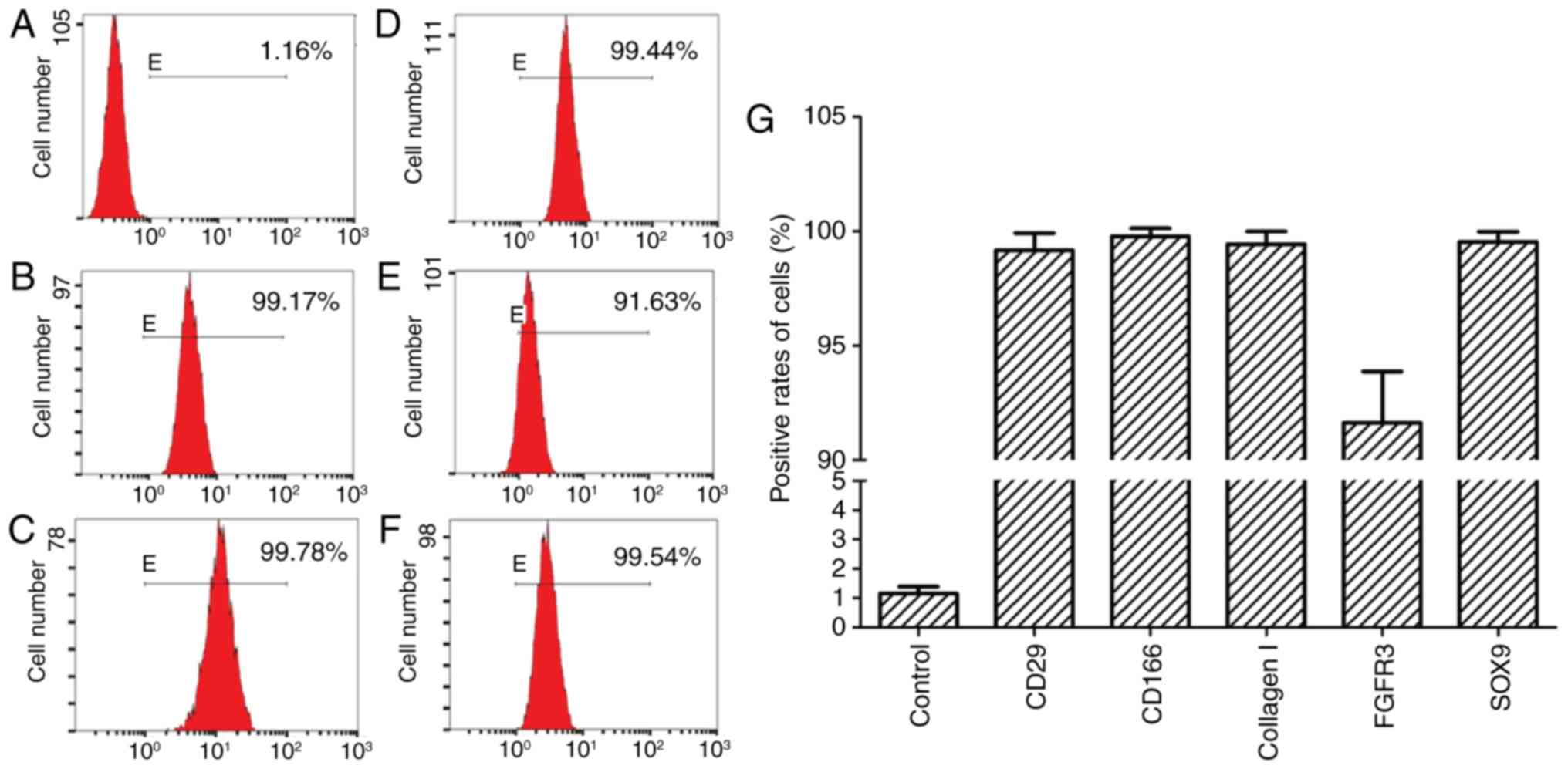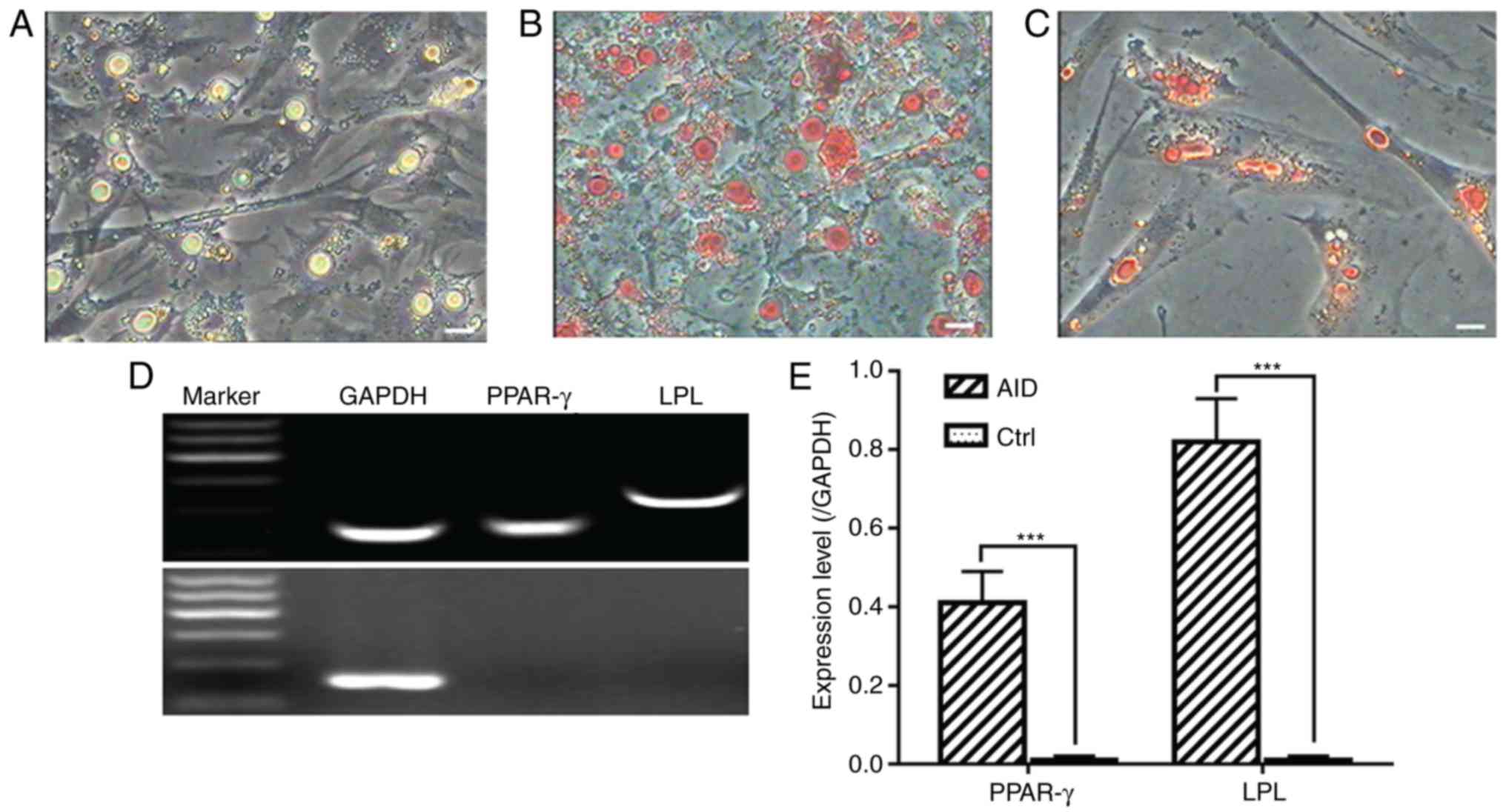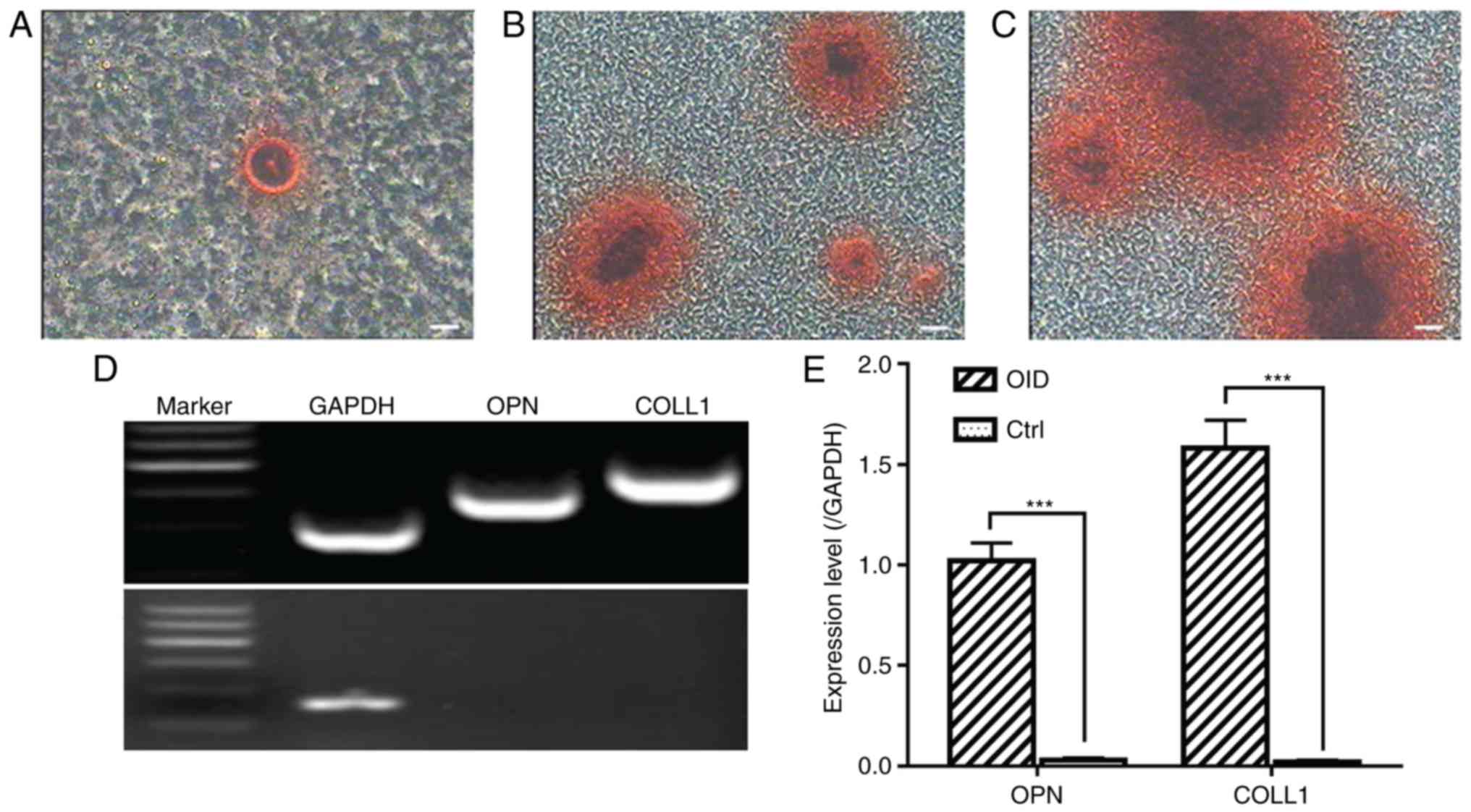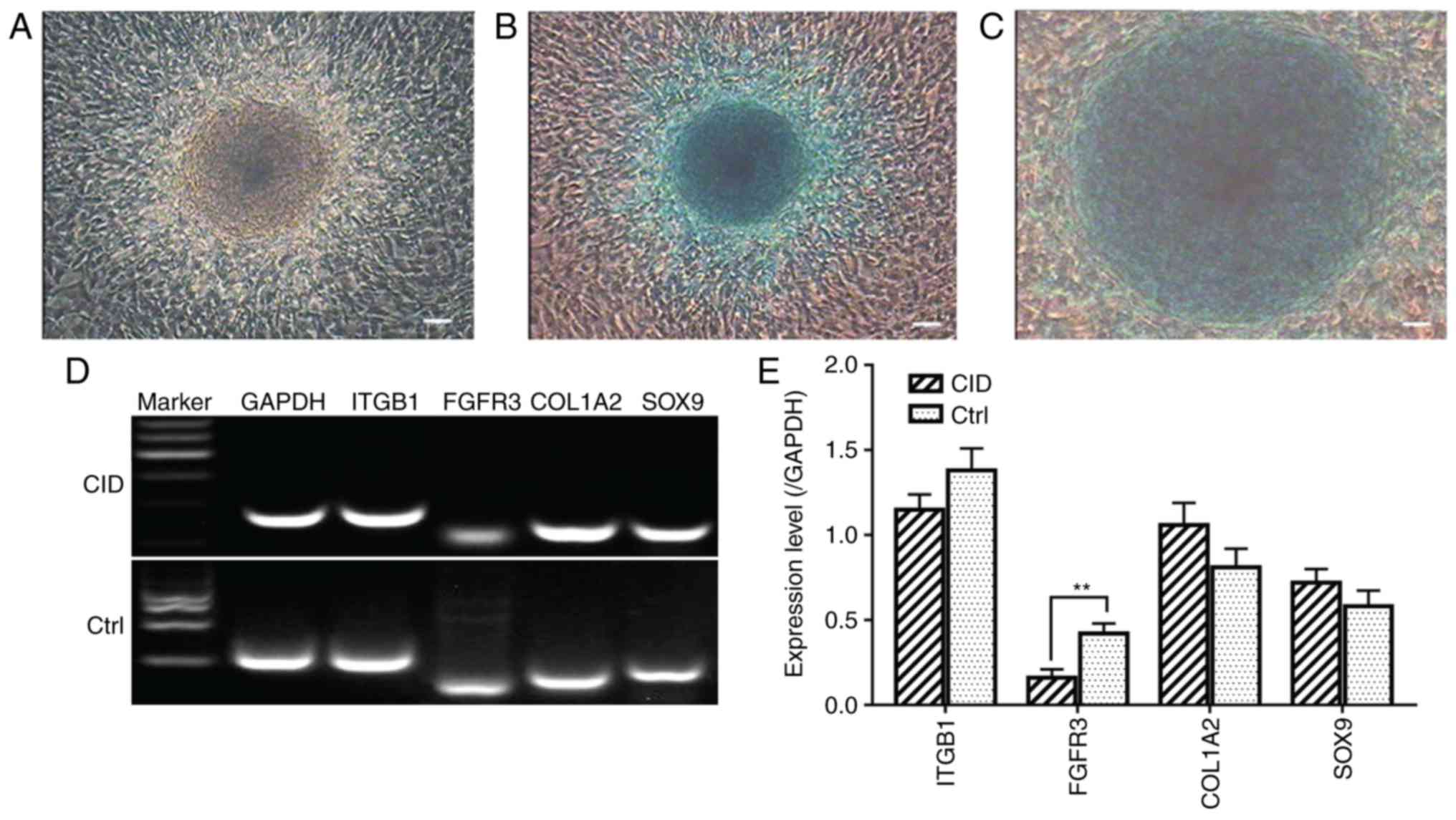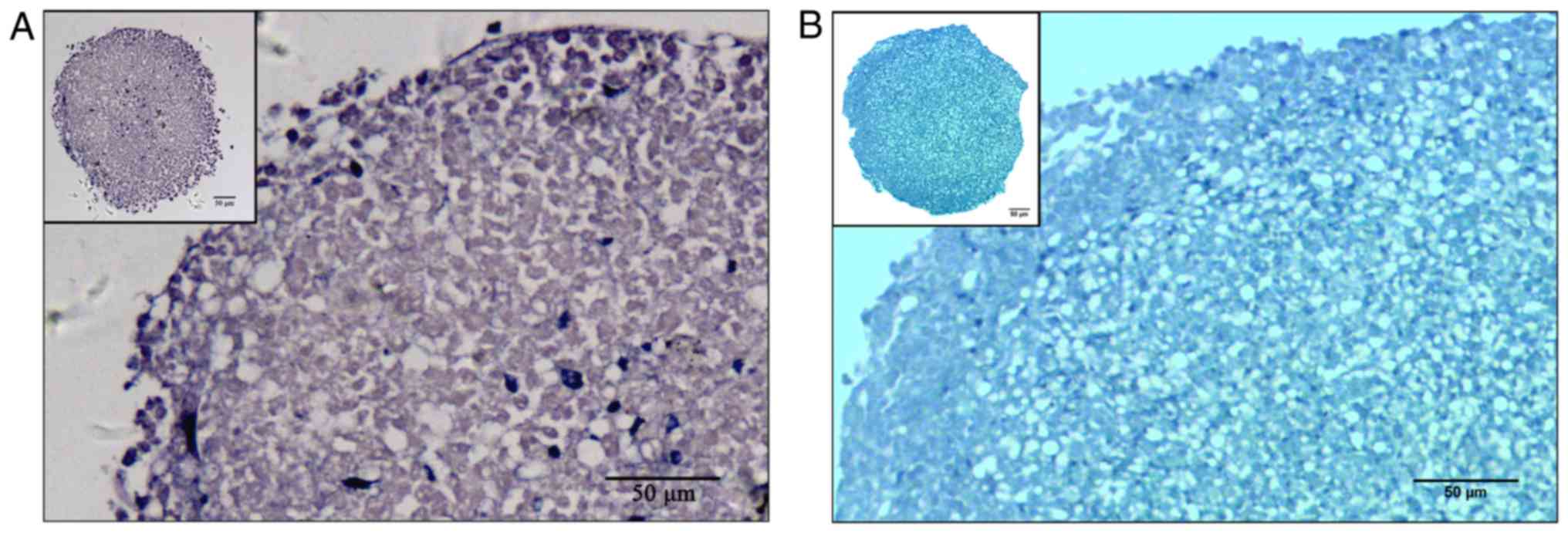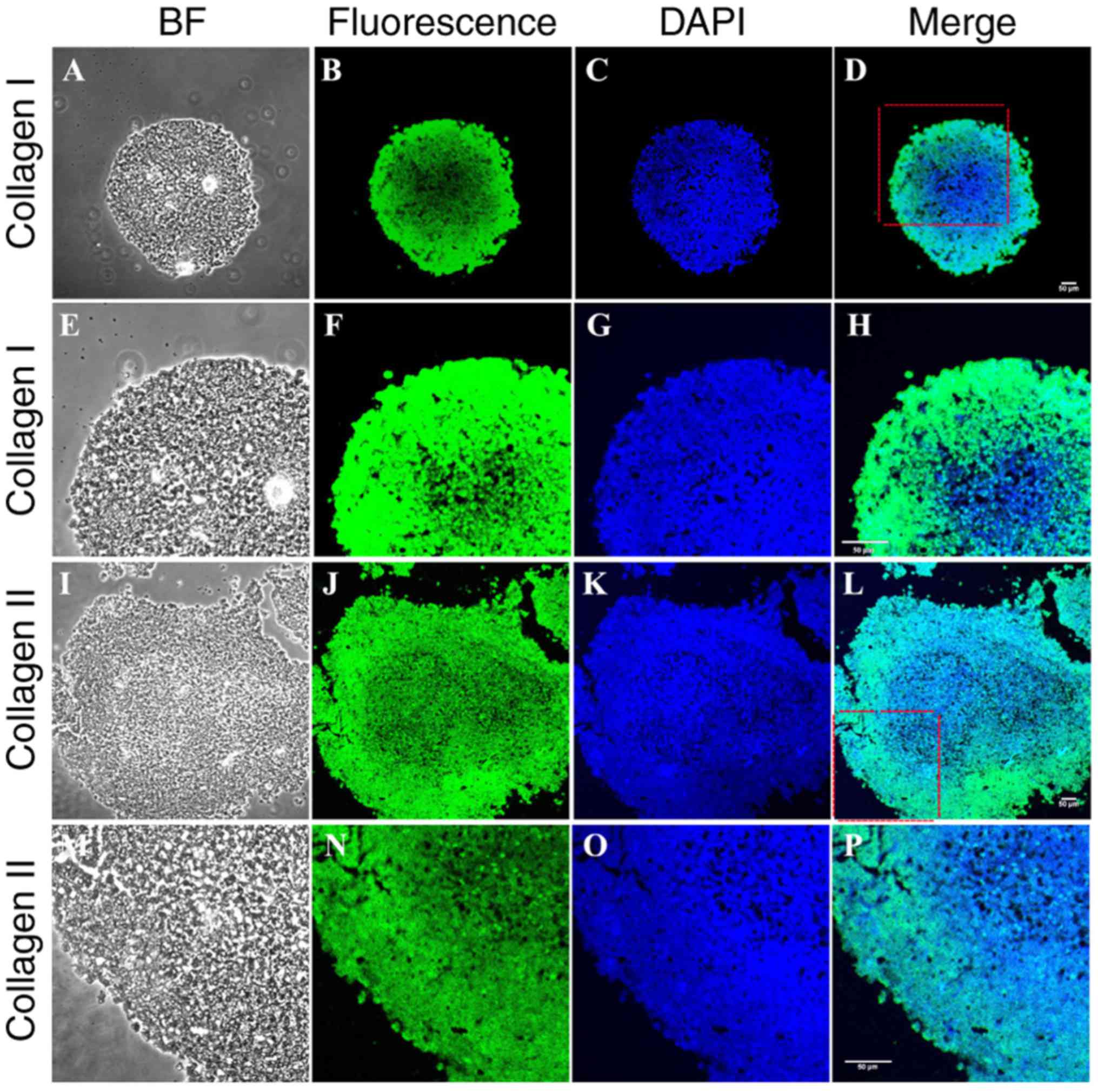Isolation and biological characteristic evaluation of a novel type of cartilage stem/progenitor cell derived from Small‑tailed Han sheep embryos
- Authors:
- Published online on: April 17, 2018 https://doi.org/10.3892/ijmm.2018.3629
- Pages: 525-533
Abstract
Introduction
Osteoarthritis (OA), a degenerative joint disease, can give rise to articular cartilage loss, bone sclerosis, osteophyte formation and synovial inflammation (1,2). As the target tissue of OA, articular cartilage, which is characterized by >90% surrounding matrix, <10% progenitor/stem cells in cell volume and an avascular structure, has low potential in the tissue repair and regenerative process (3). The articular cartilage consists of surface, middle and deep zones, with the articular surface is crucial in regulating the appositional growth of the tissue (4). As previously described (5), ulcerated cartilage, when destroyed, is never recovered. Expanding on this, stem cell research has led to substantial advances in cell therapy and tissue regeneration (6–9). Embryonic stem cells, adult stem cells and induced pluripotent stem cells have all been used for cartilage reconstruction in vitro (10–15). Similarly, cartilage stem/progenitor cells (CSPCs) exist extensively within human, equine, bovine and chicken articular cartilage. Initially stated in 2003, Barbero et al reported that human articular chondrocytes enhanced cartilage repair capacity (16). In 2004, the existence of multipotential mesenchymal progenitor cells derived from human articular cartilage was identified by virtue of the expression of the cell surface markers (CD105 and CD166) (17). In 2007, isolated stem cells, which existed in the superficial region of bovine articular cartilage, were determined by fluorescent cell sorting and immunoblot assays (18). Worthley et al also stated that bone and cartilage can develop from a dedicated and committed postnatal progenitor population (19).
To date, numerous references to the use of CSPCs in investigations have been reported, however, the growth mechanisms and functions of articular cartilage remain to be elucidated. Several problems remain unresolved for CSPCs, including origin, efficient isolation method, lack of definitive surface markers, and application potential. The present study aimed to isolate a population of progenitor cells from the surface zone of fetal sheep articular cartilage, and examine their biological characteristics with regard to growth kinetics, karyotype, immunophenotype, specific markers and differentiation potential.
Materials and methods
Experimental animals
The 45-day-old fetal sheep embryos (12 in total, 6 males and 6 females) were provided by the Chinese Academy of Agricultural Sciences farm. All animal procedures in the present study were approved by the Institutional Animal Care and Use Committee of the Chinese Academy of Agricultural Sciences (Beijing, China). Unless otherwise stated, all experimental reagents were purchased from Sigma-Aldrich; Merck Millipore (Darmstadt, Germany).
CSPC isolation and culture
The method of CSPC isolation was as previously described (20,21). All procedures were performed under sterile conditions. Fresh joints were exposed and mechanically peeled off from the articular cartilages of the fetal sheep, and were washed six times with phosphate-buffered saline (PBS). The samples were diced and the enzymatic digestion reaction was performed with 0.2% collagenase II for 2 h at 37°C. When filtered through a 70-μm nylon cell strainer, the cell suspension was transferred into 15-ml conical centrifuge tubes and centrifuged at 200 × g for 8 min at room temperature. Subsequently, the cell pellet was gently resuspended in growth medium [DMEM/F12, 10% (v/v) FBS, 2 mM L-glutamine and 104 IU/ml penicillin/streptomycin] and seeded in Petri dishes, which were coated with 10 μg/ml fibronectin, at 5×104/cm2 (22). At ~24 h post-seeding at 37°C/5% CO2, the supernatants were collected into a new cell culture dish to remove other cells. On reaching 80-90% confluence, the separated and purified CSPCs were disaggregated using 0.25% Trypsin-EDTA at a ratio of 1:1 to further expansion.
Cell population dynamics assay
For the growth kinetics assay of CSPCs, the adherent cells (1.0×104/well) at passages 5, 15 and 25 were trypsinized, and then collected into a 24-well plate. Subsequently, the cells from three randomly selected wells were counted each day for 7 days. Growth curves were drawn in accordance with the mean cell numbers, and the population doubling time (PDT) was calculated based on the following formula: PDT = (t − t0) lg2/(lgNt − lgN0), where t0 is the starting time of culture; t is the time of culture termination; N0 is the initial cell number in the culture; Nt is the ultimate cell number in the culture.
Karyotype analysis
Chromosome spreads of the CSPCs were processed as previously described (23,24). Briefly, following the addition of the 0.1 μg/ml colcemid for 4 h, the 2×106 cells were dissociated with 0.25% trypsin-EDTA when they reached 80-90% confluence, and then treated with 0.075 M KCL. After 30 min at 37°C, the CSPCs were fixed with methanol/glacial acetic acid (3:1) and metaphase chromosome spreads were observed under BX41 light microscope (magnification, ×1,000; Olympus, Tokyo, Japan) using Giemsa staining.
Immunofluorescent detection
Cells from passage six that had reached ~60-70% confluence, were processed by use of paraformaldehyde fixation. Following extensive washing with cold PBS, 0.2% Triton X-100 was used for the experiments, and the samples were transferred to PBS containing 10% (v/v) normal goat serum (BIOSS, Beijing, China) for 30 min. Following incubation with the primary antibodies for 1 h, the appropriate FITC-labeled goat anti rabbit IgG antibodies (1:100; BIOSS) were subsequently used for incubation of the cells for 1 h in the dark. All experimental procedures mentioned above were performed at room temperature. The primary antibodies used in the present study were as follows: Rabbit anti-CD29 (cat. no. bs-20631R; 1:100), rabbit anti-CD166 (cat. no. bs-1251R; 1:100), rabbit anti-collagen type I (cat. no. bs-7158R; 1:100), rabbit anti-fibroblast growth factor receptor 3 (FGFR3; cat. no. bs-1301R; 1:100) and rabbit anti-SRY-Box 9 (SOX9; cat. no. bs-4177R; 1:100), all purchased from BIOSS. Finally, the cells were thoroughly counterstained with 1 μg/ml DAPI and visualized with a Nikon TE-2000-E confocal microscope (magnification, ×200; Nikon Corporation, Tokyo, Japan).
RNA isolation and reverse transcription-polymerase chain reaction (RT-PCR) assays
A 2-μg sample of total RNA, which was isolated from the cultured CSPCs (P5, P15 and P25) and differentiation-induced cells with TRIzol reagent (Ambion; Thermo Fisher Scientific, Inc., Waltham, MA, USA), was subjected to RT-PCR analysis as previously described. The extracted RNA was reverse transcribed to cDNA using an RNA PCR kit (version 3.0; Takara Bio, Inc., Otsu, Japan). The PCR analysis was performed using the PCR Master Mix kit (Takara Bio, Inc.) in a 20-μl mixture containing 1 μl template cDNA, 0.5 μl each of forward and reverse primers, 8 μl ddH2O and 10 μl 2X PCR Mix. A thermal cycler was programmed for 35 cycles as follows: 1 cycle at 94°C for 5 min; 35 cycles including a denaturation step at 94°C for 30 sec, annealing step at 50-60°C for 30 sec and elongation step at 72°C for 30 sec; final single cycle at 72°C for 8 min. Subsequently, the product sizes were assessed by the application of 2.5% agarose gel electrophoresis. The specific primers sequences are indicated in Table I, which were designed by NCBI Primer-BLAST software (Primer3 and Blast; https://www.ncbi.nlm.nih.gov/tools/primer-blast/) (25). RT-quantitative PCR (RT-qPCR) was performed using the SYBR® Premix Ex Taq™ II kit (Takara Bio, Inc.) on an Applied Biosystems QuantStudio™ 6 Flex thermocycler (Thermo Fisher Scientific, Inc.), and the relative gene expression was normalized to GAPDH expression, and was calculated using the 2−ΔΔCq relative quantification method (26). Statistical analysis of each group included three independent samples and the intergroup difference was analyzed via Student's t-test (27).
Flow cytometric analysis
Flow cytometry was used to positively identify the CSPCs. Briefly, cells of P6 in the logarithmic phase were collected into the FACS tubes and processed with cold 70% ethanol fixation at 4°C overnight. Subsequently, 1% BSA (cat. no. A7030; Sigma-Aldrich; Merck KGaA, Darmstadt, Germany) in PBS was added to block nonspecific reacting. The expression levels of specific markers of the culture-expanded cells were evaluated by incubation with fluorescence-conjugated rabbit anti-CD29, rabbit anti-CD166, rabbit anti-collagen type I, rabbit anti-FGFR3, rabbit anti-SOX9 monoclonal antibodies at 1:100 at room temperature for 1 h using flow cytometry.
In vitro differentiation of CSPCs
For the assessment of differentiation potential, the present study aimed to determine whether the CSPCs of the fetal sheep were able to differentiate into adipogenic, osteogenic or chondrogenic lineages. To examine adipogenic differentiation potential, the CSPCs (P4) were incubated under adipogenic induction conditions comprising DMEM/F12 supplemented with 10% FBS, 1 mM dexamethasone, 0.5 mM IBMX, 10 mg/ml insulin and 60 mM indomethacin. Following one week, adipogenic differentiation was evaluated using intracellular lipid accumulation by Oil Red O staining solution for 30 min at room temperature. To identify the osteogenic differentiation potential, the cells were cultured under osteogenic induction conditions, which comprised 10% FBS, 0.5 mM dexamethasone, 50 μg/ml vitamin C and 10 mM β-glycerophosphate. Subsequent to two weeks, the osteogenic differentiation potential was determined by the calcium salt deposition by Alizarin Red staining solution for 30 min at room temperature. Chondrogenic differentiation was processed in 2-D monolayer cultures and in pellet mass cultures under chondrogenic induction (CID) conditions. CSPCs (P4) in 2-D monolayer cultures were treated with 5% FBS, 1% insulin-transferrin-selenium, 50 μg/ml L-proline, 0.1 μM dexamethasone, 0.9 mM sodium pyruvate, 50 μg/ml vitamin C and 10 ng/ml transforming growth factor-β3 for 21 days. The differentiation induction medium was refreshed twice weekly. For the pellet mass cultures, the cells were resuspended and transferred to 1.5 ml conical polypropylene tubes. The samples, which consisted of 2.5×105 cells in chondrogenic medium, were centrifuged at 200 × g for 5 min at room temperature to form a pellet. Following induction for 21 days, the pellets were fixed and then embedded into paraffin wax. Subsequently, the samples were subjected to histochemical Alcian Blue and Toluidine Blue staining. The normal goat serum (BIOSS) was used to block nonspecific reactions. The samples were then stained with rabbit anti-collagen type I (cat. no. bs-7158R; 1:100; BIOSS) and rabbit anti-collagen type II (cat. no. bs-10589R; 1:100; BIOSS) overnight at 4°C, respectively. The subsequent day, the sections were treated with FITC-conjugated goat anti-rabbit antibody (cat. no. ZF-0311; 1:100; OriGene Technologies, Inc., Rockville, MD, USA) for 1 h at room temperature and were then processed using 1 μg/ml DAPI for nuclear staining. Finally, the differentiation capacities of the induced cells were visualized by confocal microscopy and RT-PCR analysis, respectively. RNA samples of CSPCs prior to differentiation were included as negative control groups.
Statistical analysis
All data are presented as the mean ± standard deviation, and an unpaired two-tailed t-test was used to determine differences between two groups (for example, induction, vs. control). All statistical analyses were performed using GraphPad Prism 7.0 software (GraphPad Software, Inc., La Jolla, CA, USA).
Results
Morphology, proliferation and karyotype analyses of CSPCs
The freshly isolated primary cells were observed to adhere to the fibronectin-coated 6-well culture plates under the inverted microscope by use of differential adhesion (Fig. 1Aa). Following initial seeding, the CSPCs continued to proliferate rapidly and formed colonies. After 5 days, the colonies were expanded gradually in a monolayer culture (Fig. 1Ab). The passaged cells at P1, P2, P3, P5, P9, P13, P23, P25 and P28 grew rapidly, and the morphological structure of the cells was long fusiform or polygonal (Fig. 1Ac–k). The cells were passaged every 2 days to P32, following which the majority of cells exhibited cell senescence (Fig. 1Al). The growth curves of the CSPC cultures at different passages (P5, P15 and P25), as shown in Fig. 1B, were all typically sigmoidal in shape, indicating similar proliferative potential. The PDTs were determined as 39.45, 42.35 and 45.72 h for the cells at P5, P15 and P25, respectively. Karyotype analysis was used for analyzing the reproducibly diploid CSPC cell line (Fig. 1C). The results confirmed the frequencies of cells in P5, P15 and P25 with 2n=54 were 94.4, 93.8 and 91.6%, respectively, indicating no cross contamination.
Detection of stem cell markers
The surface antigen expression was assessed using RT-PCR analysis. Similar to human CSPCs, the CSPCs of the fetal sheep were positive for specific marker genes integrin β1 (ITGB1), activated leukocyte cell adhesion molecule (ALCAM), FGFR3, collagen type I α2 (COL1A2) and SOX9 (Fig. 2A and B). The analysis of CSPCs for FGFR3 and SOX9 by immunofluorescence was consistent with the results mentioned above (Fig. 3). Additionally, the expression of markers CD29, CD166 and COL1A2 was verified by immunohistochemical staining analysis under the confocal microscope (Fig. 3).
FACS analysis
Using FACS analysis, the majority of CSPCs (>90%) expressed high levels of the above-mentioned surface markers in the viable cell population (Fig. 4A–G), which was in accordance with the phenotype of human CSPCs.
Differentiation of CSPCs
Adipogenic differentiation
For adipogenic differentiation, the CSPCs were plated and precultured at confluence in complete culture medium, followed by exposure to adipogenic medium for 7 days, at which time larger droplets were generated (Fig. 5A). Positive Oil Red O staining revealed time-dependent increases in the size and number of lipid droplets (Fig. 5B and C). The cells were cultured for an additional 7 days, and RNA isolation of the induced cells was performed to examine the expression of adipocyte-specific genes peroxisome proliferator-activated receptor-γ (PPAR-γ) and lipoprotein lipase (LPL) during adipogenesis of the CSPCs by RT-qPCR analysis (Fig. 5D and E).
Osteogenic differentiation
The CSPCs were found to be capable of osteogenic differentiation. Following induction in osteo-genic differentiation medium for 7 days, the morphology of the CSPCs was altered and mineralization appeared (Fig. 6A). As the time increased, the nodules increased in size and number. Following incubation in osteogenic medium for 2 weeks, Alizarin Red staining was used to reveal the formation of mineralized bone nodules (Fig. 6B and C). The expression of osteopontin (OPN) and COLL1 were detected in the induced cells by RT-qPCR analysis (Fig. 6D and E).
Chondrogenic differentiation
The induced CSPCs in 2-D monolayer cultures were incubated for 21 days using chondrogenesis medium and exhibited a notable blue color following staining by Alcian Blue (Fig. 7A–C). The total RNA of the induced cells was isolated and RT-qPCR analysis was performed. The specific genes detected were unchanged, with the exception of FGFR3 (Fig. 7D and E). The induced CSPCs in 3-D monolayer cultures were smooth and iridescent in appearance, and stained positively for Toluidine Blue (Fig. 8A) and Alcian Blue (Fig. 8B). Immunohistochemistry revealed positive labeling for type I (Fig. 9A–H) and type II (Fig. 9I–P) collagen.
Discussion
The multipotency of stem cell populations, together with their self-renewal ability, proliferation and nontumorigenicity characteristics, in the culture process make them promising candidate cells for cell-based therapies and tissue engineering applications (28–31). In the present study, CSPCs were successfully isolated from the articular cartilages of fetal sheep with a fibronectin adhesion assay. The results showed that the biological characteristics of the newly isolated stem cells were stable. Chondrocytes and certain fibroblasts were present together, however, the cell type was homogeneous through purification for 2-3 passages. Due to the high activity of stem cells from younger embryos, 45-day-old Small-tailed Han sheep embryos were selected for experimental materials. Therefore, the CSPCs were cultured successfully in vitro and maintained high activity for at least 32 passages. The CSPC growth dynamics were detected by drawing of a growth curve. Growth curves are a conventional method to detect cell growth rhythm, which has been widely used. The results showed that the growth curve had a typical 'S' shape and had a normal population doubling time. Karyotype analysis is an important method for distinguishing normal cells from variants. The CSPCs cultured in the present study were all normal diploid cells and the genetic properties of the cells remained stable during the sequential passaging.
At present, CSPCs have not been well defined due to a lack of stable markers for tracing their lineage. Quintin et al stated that isolated cells were capable of multilineage differentiation from human fetal femurs at weeks 14-16 of embryogenesis (32). Wu et al used microdissection to identify different subpopulations of cartilage-forming cells in human embryonic limb buds. In the latter study, two cell subpopulations present at weeks 5-6 were of particular interest: CD166low/−CD73+CD146 low/− cells, with the capacity to undergo multilineage differentiation, including chondrogenesis; and CD166low/−CD73+CD146low/−LIN–CD44low cells, which were able to undergo chondrogenesis only (33). In the present study, the distribution of cell surface markers of the fetal sheep CSPCs was verified, including positivity for collagen I, collagen II and relevant markers, though the use of immunofluorescence and RT-PCR analysis. The expression rate of the fetal sheep CSPCs was also detected by FACS analysis.
There is increasing interest in investigations associated with the multilineage differentiation potentiality of stem cells. In vitro, under the action of specific inducing factors, the expression of certain key genes in the signaling pathway associated with stem cell differentiation can change (34,35). In the present study, fetal sheep CSPCs were successfully induced to differentiate into chondrogenic, osteogenic and adipogenic lineages. In addition, the expression of type I collagen and type II collagen In CSPC pellets under CID were consistent with the results reported by McCarthy et al (34) and Williams et al (36,37), suggesting that CSPCs retained their normal phenotype characteristics in 3-D monolayer cultures. CSPCs may be crucial in investigations targeting cartilage repair in human and veterinary medicine following extended expansion. Therefore, further investigations are required with regard to using these cells for future studies and therapy.
In conclusion, a Small-tailed Han sheep embryo CSPC line was successfully established in the present study. Cell morphology, surface markers and biological characteristics were observed and detected. In addition, the multipotency of CSPCs was confirmed, with cells having the ability to be induced to differentiate into chondrocytes, adipocytes and osteoblasts. These findings suggested that CSPCs may be superior cells in producing cartilage capable of functional repair.
References
|
Jo CH, Chai JW, Jeong EC, Oh S, Shin JS, Shim H and Yoon KS: Intra-articular Injection of mesenchymal stem cells for the treatment of osteoarthritis of the knee: A 2-year follow-up study. Am J Sports Med. 45:2774–2783. 2017. View Article : Google Scholar : PubMed/NCBI | |
|
Scotece M and Mobasheri A: Leptin in osteoarthritis: Focus on articular cartilage and chondrocytes. Life Sci. 140:75–78. 2015. View Article : Google Scholar : PubMed/NCBI | |
|
Hayes AJ, MacPherson S, Morrison H, Dowthwaite G and Archer CW: The development of articular cartilage: Evidence for an appositional growth mechanism. Anat Embryol. 203:469–479. 2001. View Article : Google Scholar : PubMed/NCBI | |
|
Dowthwaite GP, Bishop JC, Redman SN, Khan IM, Rooney P, Evans DJ, Haughton L, Bayram Z, Boyer S, Thomson B, et al: The surface of articular cartilage contains a progenitor cell population. J Cell Sci. 117:889–897. 2004. View Article : Google Scholar : PubMed/NCBI | |
|
Schmidt KJ, Tirico LE, McCauley JC and Bugbee WD: Fresh osteochondral allograft transplantation: Is graft storage time associated with clinical outcomes and graft survivorship? Am J Sports Med. 45:2260–2266. 2017. View Article : Google Scholar : PubMed/NCBI | |
|
Seol D, McCabe DJ, Choe H, Zheng H, Yu Y, Jang K, Walter MW, Lehman AD, Ding L, Buckwalter JA, et al: Chondrogenic progenitor cells respond to cartilage injury. Arthritis Rheum. 64:3626–3637. 2012. View Article : Google Scholar : PubMed/NCBI | |
|
Alizadeh A, Moztarzadeh F, Ostad SN, Azami M, Geramizadeh B, Hatam G, Bizari D, Tavangar SM, Vasei M and Ai J: Synthesis of calcium phosphate-zirconia scaffold and human endometrial adult stem cells for bone tissue engineering. Artif Cells Nanomed Biotechnol. 44:66–73. 2016. View Article : Google Scholar | |
|
Guo DL, Wang ZG, Xiong LK, Pan LY, Zhu Q, Yuan YF and Liu ZS: Hepatogenic differentiation from human adipose-derived stem cells and application for mouse acute liver injury. Artif Cells Nanomed Biotechnol. 45:224–232. 2017. View Article : Google Scholar | |
|
Zhang Z, Pu Y, Pan Q, Xu X and Yan X: Influences of keratinocyte growth factor-mesenchymal stem cells on chronic liver injury in rats. Artif Cells Nanomed Biotechnol. 44:1810–1817. 2016. View Article : Google Scholar | |
|
Yamashita A, Liu S, Woltjen K, Thomas B, Meng G, Hotta A, Takahashi K, Ellis J, Yamanaka S and Rancourt DE: Cartilage tissue engineering identifies abnormal human induced pluripotent stem cells. Sci Rep. 3:19782013. View Article : Google Scholar : PubMed/NCBI | |
|
Oakes BW, Handley CJ, Lisner F and Lowther DA: An ultrastructural and biochemical study of high density primary cultures of embryonic chick chondrocytes. J Embryol Exp Morphol. 38:239–263. 1977.PubMed/NCBI | |
|
Okita K, Ichisaka T and Yamanaka S: Generation of germ-line-competent induced pluripotent stem cells. Nature. 448:313–317. 2007. View Article : Google Scholar : PubMed/NCBI | |
|
Saito T, Yano F, Mori D, Ohba S, Hojo H, Otsu M, Eto K, Nakauchi H, Tanaka S, Chung UI and Kawaguchi H: Generation of Col2a1-EGFP iPS cells for monitoring chondrogenic differentiation. PLoS One. 8:e741372013. View Article : Google Scholar : PubMed/NCBI | |
|
Bai C, Li X, Gao Y, Yuan Z, Hu P, Wang H, Liu C, Guan W and Ma Y: Melatonin improves reprogramming efficiency and proliferation of bovine-induced pluripotent stem cells. J Pineal Res. 61:154–167. 2016. View Article : Google Scholar : PubMed/NCBI | |
|
Wang M, Yuan Z, Ma N, Hao C, Guo W, Zou G, Zhang Y, Chen M, Gao S, Peng J, et al: Advances and prospects in stem cells for cartilage regeneration. Stem Cells Int. 2017:41306072017. View Article : Google Scholar : PubMed/NCBI | |
|
Barbero A, Ploegert S, Heberer M and Martin I: Plasticity of clonal populations of dedifferentiated adult human articular chondrocytes. Arthritis Rheum. 48:1315–1325. 2003. View Article : Google Scholar : PubMed/NCBI | |
|
Alsalameh S, Amin R, Gemba T and Lotz M: Identification of mesenchymal progenitor cells in normal and osteoarthritic human articular cartilage. Arthritis Rheum. 50:1522–1532. 2004. View Article : Google Scholar : PubMed/NCBI | |
|
Hattori S, Oxford C and Reddi AH: Identification of superficial zone articular chondrocyte stem/progenitor cells. Biochem Biophys Res Commun. 358:99–103. 2007. View Article : Google Scholar : PubMed/NCBI | |
|
Worthley DL, Churchill M, Compton JT, Tailor Y, Rao M, Si Y, Levin D, Schwartz MG, Uygur A, Hayakawa Y, et al: Gremlin 1 identifies a skeletal stem cell with bone, cartilage, and reticular stromal potential. Cell. 160:269–284. 2015. View Article : Google Scholar : PubMed/NCBI | |
|
Li L, Ma Y, Li X, Li X, Bai C, Ji M, Zhang S, Guan W and Li J: Isolation, culture, and characterization of chicken cartilage stem/progenitor cells. Biomed Res Int. 2015:5862902015.PubMed/NCBI | |
|
Archer CW, McDowell J, Bayliss MT, Stephens MD and Bentley G: Phenotypic modulation in sub-populations of human articular chondrocytes in vitro. J Cell Sci. 97:361–371. 1990.PubMed/NCBI | |
|
Qu Z, Balkir L, van Deutekom JC, Robbins PD, Pruchnic R and Huard J: Development of approaches to improve cell survival in myoblast transfer therapy. J Cell Biol. 142:1257–1267. 1998. View Article : Google Scholar : PubMed/NCBI | |
|
Ma C, Liu C, Li X, Lu T, Bai C, Fan Y, Guan W and Guo Y: Cryopreservation and multipotential characteristics evaluation of a novel type of mesenchymal stem cells derived from small tailed han sheep fetal lung tissue. Cryobiology. 75:7–14. 2017. View Article : Google Scholar : PubMed/NCBI | |
|
Vasa M, Fichtlscherer S, Aicher A, Adler K, Urbich C, Martin H, Zeiher AM and Dimmeler S: Number and migratory activity of circulating endothelial progenitor cells inversely correlate with risk factors for coronary artery disease. Circ Res. 89:E1–E7. 2001. View Article : Google Scholar : PubMed/NCBI | |
|
Ye J, Coulouris G, Zaretskaya I, Cutcutache I, Rozen S and Madden TL: Primer-BLAST: A tool to design target-specific primers for polymerase chain reaction. BMC Bioinformatics. 13:1342012. View Article : Google Scholar : PubMed/NCBI | |
|
Livak KJ and Schmittgen TD: Analysis of relative gene expression data using real-time quantitative PCR and the 2−ΔΔCT method. Methods. 25:402–408. 2001. View Article : Google Scholar | |
|
Lee H, Im J, Won H, Kim JY, Kim HK, Kwon JT, Kim YO, Lee S, Cho IH, Lee SW and Kim HJ: Antinociceptive effect of Valeriana fauriei regulates BDNF signaling in an animal model of fibromyalgia. Int J Mol Med. 41:485–492. 2018. | |
|
Bai C, Li X, Gao Y, Wang K, Fan Y, Zhang S, Ma Y and Guan W: Role of microRNA-21 in the formation of insulin-producing cells from pancreatic progenitor cells. Biochim Biophys Acta. 1859:280–293. 2016. View Article : Google Scholar | |
|
Gao Y, Bai C, Zheng D, Li C, Zhang W, Li M, Guan W and Ma Y: Combination of melatonin and Wnt-4 promotes neural cell differentiation in bovine amniotic epithelial cells and recovery from spinal cord injury. J Pineal Res. 60:303–312. 2016. View Article : Google Scholar : PubMed/NCBI | |
|
Kariminekoo S, Movassaghpour A, Rahimzadeh A, Talebi M, Shamsasenjan K and Akbarzadeh A: Implications of mesenchymal stem cells in regenerative medicine. Artif Cells Nanomed Biotechnol. 44:749–757. 2016. View Article : Google Scholar : PubMed/NCBI | |
|
Mohammadian M, Abasi E and Akbarzadeh A: Mesenchymal stem cell-based gene therapy: A promising therapeutic strategy. Artif Cells Nanomed Biotechnol. 44:1206–1211. 2016. | |
|
Quintin A, Schizas C, Scaletta C, Jaccoud S, Applegate LA and Pioletti DP: Plasticity of fetal cartilaginous cells. Cell Transplant. 19:1349–1357. 2010. View Article : Google Scholar : PubMed/NCBI | |
|
Wu L, Bluguermann C, Kyupelyan L, Latour B, Gonzalez S, Shah S, Galic Z, Ge S, Zhu Y, Petrigliano FA, et al: Human developmental chondrogenesis as a basis for engineering chondrocytes from pluripotent stem cells. Stem Cell Reports. 1:575–589. 2013. View Article : Google Scholar : PubMed/NCBI | |
|
Morgado AL, Rodrigues CM and Solá S: MicroRNA-145 regulates neural stem cell differentiation through the Sox2-Lin28/let-7 signaling pathway. Stem Cells. 34:1386–1395. 2016. View Article : Google Scholar : PubMed/NCBI | |
|
Luo S, Shi Q, Zha Z, Yao P, Lin H, Liu N, Wu H and Sun S: Inactivation of Wnt/β-catenin signaling in human adipose-derived stem cells is necessary for chondrogenic differentiation and maintenance. Biomed Pharmacother. 67:819–824. 2013. View Article : Google Scholar : PubMed/NCBI | |
|
McCarthy HE, Bara JJ, Brakspear K, Singhrao SK and Archer CW: The comparison of equine articular cartilage progenitor cells and bone marrow-derived stromal cells as potential cell sources for cartilage repair in the horse. Vet J. 192:345–351. 2012. View Article : Google Scholar | |
|
Williams R, Khan IM, Richardson K, Nelson L, McCarthy HE, Analbelsi T, Singhrao SK, Dowthwaite GP, Jones RE, Baird DM, et al: Identification and clonal characterisation of a progenitor cell sub-population in normal human articular cartilage. PLoS One. 5:e132462010. View Article : Google Scholar : PubMed/NCBI |



